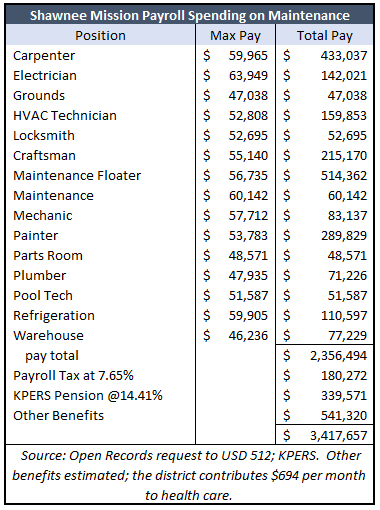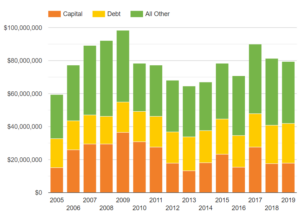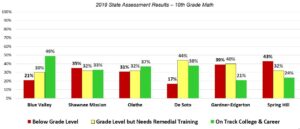How tone-deaf…or insensitive…or just plain entitled…must one be to propose a property tax increase while individuals and business owners are struggling to make ends meet? Taxpayers in the Shawnee Mission School District are about to find out.
The Shawnee Mission Post reports that Superintendent Mike Fulton told the school board the best way to free up money for more teachers would be to put a bond issue on the ballot within the next year. Fulton said hiring more teachers without extending or increasing taxes would put the district in a perilous financial position. The article says the desire to hire 80 more teachers comes from a KNEA teacher union demand; they say teaching six periods per day is unsustainable.
By the way, this property tax increase would be in addition to a proposed 6% hike from the City of Overland Park.
The plan is to get a bond issue on the November ballot, but the amount of proposed new debt isn’t mentioned.
School districts have long maintained that school bond money cannot be used for operating expenses, but Fulton must believe he’s come up with a loophole. The union suggested paying custodians out of the Capital Outlay fund as permitted by state law, but Fulton says the district would still need to budget for school renovations, which means borrowing money to pay for renovations.
“Is that more important, or is it more important to address workload for secondary teachers?” Fulton said.
But it’s hardly a binary choice of borrowing money or not hiring more teachers (if needed).
Multiple savings opportunities
Since 2005, enrollment at USD 512 Shawnee Mission dropped by 3.3%, but they have seven more  classroom teachers for an increase of 0.4%. With 26,963 full-time equivalent students and 1,525 classroom teachers, that’s an average of 17.7 students per classroom teacher.
classroom teachers for an increase of 0.4%. With 26,963 full-time equivalent students and 1,525 classroom teachers, that’s an average of 17.7 students per classroom teacher.
Total employment increased by 2.6% between 2005 and 2020, which means all other employees – those who aren’t classroom teachers – increased 4.4% even though enrollment declined 3.3%.
Opportunity – right-size staffing
The district spent $7.7 million on custodians during the year ended June 30, 2019; benefits could easily push the total cost above $10 million. According to the 2018 Salary Survey published by the University of Missouri – Kansas City, the average salary for a custodian in the Kansas City area was $29,655; the average maximum pay was $35,623.
Shawnee Mission paid 97 custodians more than the average maximum in the area last year. The average for those custodians was $43,355, and the highest-paid custodian took home $64,002. Thirteen custodians were paid more than $50,000. And that’s not counting the Custodial Supervisor, who was paid $93,037.
Many taxpayers are shocked to learn that local schools in most of the larger districts in Kansas pay many of their custodians more than they pay beginning teachers.
Opportunity – outsource custodial service to a private company
 Building maintenance is another area where the district spends a lot of money on in-house employees. The district spent about $3.4 million in pay and benefits on positions identified as skilled maintenance in their Open Records response to Kansas Policy Institute.
Building maintenance is another area where the district spends a lot of money on in-house employees. The district spent about $3.4 million in pay and benefits on positions identified as skilled maintenance in their Open Records response to Kansas Policy Institute.
Direct payroll totaled $2.4 million, with people classified as a Maintenance Floater accounting for over $500,000 of the total. Carpenter pay was the next highest amount, at $433,000, followed by Painters at $290,000, Craftsman at $215,000 and HVAC Technicians at about $160,000.
Benefits are estimated to add at least another $1 million to the cost. The district spends $694 per month on medical insurance for employees, the employer cost for pension is 14.41% of payroll, and payroll tax is 7.65% of pay for Social Security and Medicare.
Only a few of the larger districts employ a small army of in-house maintenance workers, but not all. The state’s largest district – Wichita – has no employees with these job titles.
Opportunity – outsource as much building maintenance as possible on an as-needed basis.
Spending on administration jumped 25% between 2014 and 2019, an increase $5.6 million according to the KSDE Comparative Performance and Fiscal System. The district budgeted a $4 million hike in administration spending for 2020.
Part of the increase comes from adding more managers. USD 512 added 22 more managers between 2014 and 2019, an increase of 18%. Managers include superintendents, assistant superintendents, principals, assistant principals, directors, instruction coordinators and curriculum specialists. Some of the new hires, however, would not be recorded as administration.
Opportunity – reduce the number of managers.
These savings opportunities are just the tip of the proverbial iceberg.
Conclusion
Fulton didn’t explain why he believes hiring more teachers would put the district in a “perilous financial condition,” but it’s not surprising that a school district superintendent would make such a claim.
Entrepreneurs and other business owners know what it’s like to have a quarter or more of their income disappear overnight, try to meet payroll, and keep the business afloat. School districts (not students, mind you, just the institutions) have benefitted from large funding increases recently and their funding went up again this year. The worst they may experience from legislators and Governor Kelly next year is to not get another increase.
Shawnee Mission started this year with $17.8 million in Capital Outlay reserves and $37.6 million in operating cash reserves; with full funding this year but schools closed for the last two months, their operating reserves will likely increase again.

None of this is to say the district needs 80 more teachers.
It’s just absurd that USD 512 Shawnee Mission would even consider a property tax increase now. And if school board members aren’t able to find ways to operate more efficiently, we’re happy to help.
By the way, did you notice that the property tax proposal is about meeting the KNEA union demand and makes no mention of improving student achievement?
Only a third of Shawnee Mission’s 10th-graders are on track for college and career; another third is at grade level but needs remedial training and 35% are below grade level.

The district and the union should focus on fixing this serious problem instead of taking more money from taxpayers.





